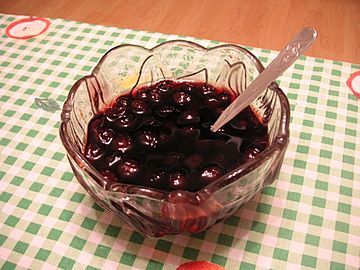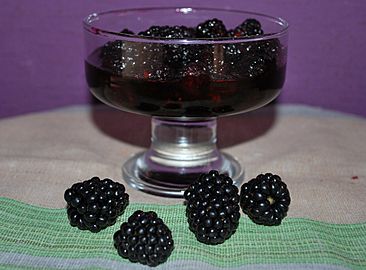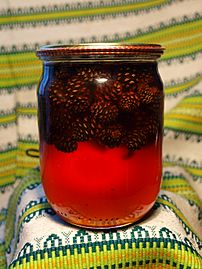Varenye facts for kids
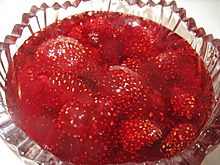
Strawberry varenye
|
|
| Course | Dessert |
|---|---|
| Region or state | Eastern Europe, Northern Europe (Baltic region) |
| Main ingredients | berries or other fruits, sugar |
Varenye (Russian: варенье, Belarusian: варэнне/варэньне, Ukrainian: варення) is a popular whole-fruit preserve, widespread in Eastern Europe (Russia, Ukraine, Belarus), as well as the Baltic region (Lithuanian: uogienė, Latvian: ievārījums, Estonian: moos). It is made by cooking berries, other fruits, or more rarely nuts, vegetables, or flowers, in sugar syrup. In some traditional recipes, other sweeteners such as honey or treacle are used instead of or in addition to sugar.
Varenye is similar to jam except the fruits are not macerated, and no gelling agent is added. It is characterized by a thick but transparent syrup having the natural colour of the fruits.
Preparation
The making of varenye requires a careful balance between cooking, or sometimes steeping in the hot sugar mixture for just enough time to allow the flavor to be extracted from the fruit, and sugar to penetrate the fruit, and cooking too long that fruit will break down and liquefy. Some fruits with tough skins require cooking for many hours, while others are suitable for making "five-minute varenye" (Russian: варенье-пятиминутка, varenye-pyatiminutka). For the latter, dry sugar is spread over raw fruit in layers and left for several hours to steep into the fruit. The resulting mixture is then heated for just about five minutes.
The most popular types of varenye are made from locally available berries and fruits, such as sour cherries, strawberries, raspberries, apricots and apples. In general, virtually any kind of fruit, as well as some culinary vegetables, nuts, pine cones, and rose petals are used.
-
Sour cherry varenye
-
Peach varenye
-
Blackberry varenye
Usage
Varenye is enjoyed as a dessert and condiment, in particular as a topping for pancakes (bliny, oladyi, syrniki), as a filling for pies (pirogi and pirozhki), dumplings (vareniki), cakes and cookies, and as a sweetener for tea. It is also used as a spread on bread, though due to its liquid consistency it is not well suited for that. Finally, it is eaten on its own as a sweet.
Related specialties
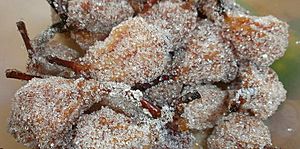
The more general usage of the term varenye in Russian includes a number of related local specialties.
Raw varenye
In the preparation of "raw varenye" (Russian: сырое варенье, syroye varenye) the heating is omitted completely. The recipes usually include grating of raw berries or other fruits and mixing them with sugar.
Dry varenye
In pre-revolutionary Russia, "dry varenye" (Russian: сухое варенье, sukhoe varenye) referred to a local variety of candied fruits (fruit confit) obtained by extracting fruits from varenye syrup and drying them. Kyiv (today the capital of Ukraine) was particularly famous for this delicacy.
Similar dishes
Similar sweets are also made in Transcaucasia and in some regions of Central and South Asia, where they are called murabba. In Bulgarian, Macedonian, and Serbian cuisines, these kinds of confections are called slatko, and in Greece and Cyprus, they are known as spoon sweets. In French cuisine, they are referred to as confitures or fruits confits.


